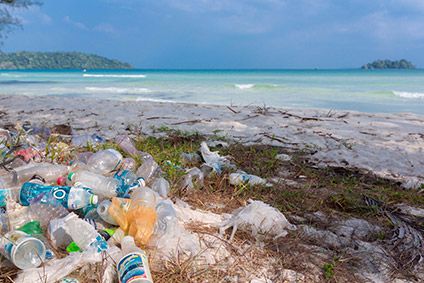
The EU food and drink industries today (16 January) “welcomed” the bloc’s push to reduce the use of single-use plastics but said Brussels’ efforts needed to include moves to raise recycling rates and to “prioritise” product “safety and quality”.
The European Commission announced what it called the “first-ever Europe-wide strategy on plastics”, which it said would protect the environment from “plastic pollution” while “fostering growth and innovation”.
Brussels said all plastic packaging on the EU market will be recyclable by 2030, while the consumption of single-use plastics will be reduced and the “intentional use” of microplastics restricted.
Frans Timmermans, the Commission vice president responsible for sustainable development, said: “If we don’t change the way we produce and use plastics, there will be more plastics than fish in our oceans by 2050. We must stop plastics getting into our water, our food, and even our bodies. The only long-term solution is to reduce plastic waste by recycling and reusing more. This is a challenge that citizens, industry and governments must tackle together. With the EU plastics strategy we are also driving a new and more circular business model. We need to invest in innovative new technologies that keep our citizens and our environment safe whilst keeping our industry competitive.”
FoodDrinkEurope, the industry body representing food and drink manufacturers in the EU, said it “supports the Commission in continuing to promote a circular and sustainable economy”.
In a statement, FoodDrinkEurope said: “Europe’s food and drink manufacturers acknowledge the great environmental challenge that is linked to the current plastics model. With this in mind, FoodDrinkEurope members are integrating into their operations the continuous improvement of the environmental performance and resource efficiency of food and drink products along their life cycle, including any associated packaging material.

US Tariffs are shifting - will you react or anticipate?
Don’t let policy changes catch you off guard. Stay proactive with real-time data and expert analysis.
By GlobalData“A key priority for FoodDrinkEurope is that the strategy improves performance at the end of the packaging value chain. FoodDrinkEurope would like to see policies that aim to increase recycling responsiveness following developments in material design, including the latest sorting and recycling technologies. In this context, funding and innovation incentives are necessary to foster recyclers’ increased performance.”
FoodDrinkEurope added: “It is worth remembering that not all plastic materials are suitable to come in contact with food, according to EU legislation. Additionally, when defining product design, packaging for food and drink products must prioritise safety and quality, as well as avoid food waste. FoodDrinkEurope trusts these conditions will be taken into account when implementing the actions foreseen in the plastics strategy.”
Speaking to five European media outlets, Timmermans pointed to China’s decision last month to ban imports of recyclable material as another reason why the EU needed to work on its use of plastic.
“It’s urgent because of the change in the Chinese position. We can’t export these plastics any more to China. The knee-jerk reaction is that we will have to burn or bury it here. Let’s use this opportunity to show we can also recycle it here.”



